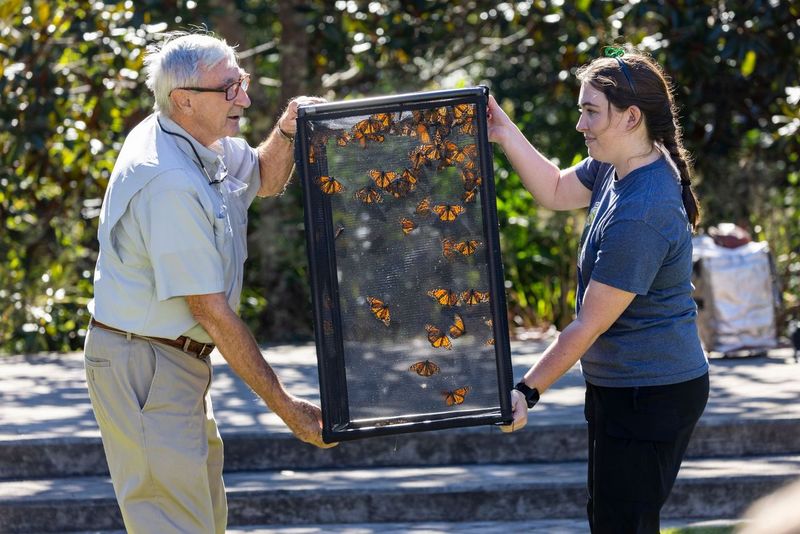Stroll through the State Botanical Garden of Georgia at the University of Georgia on any given day, and you’ll be amazed by the sights: orchids blooming in white, pink, and purple; a sea of yellow on Daffodil Hillside; elegant tableware in the Porcelain & Decorative Arts Museum; a soaring three-story tropical conservatory. The garden attracts hundreds of thousands of visitors year-round, including for seasonal events such as February’s Orchid Madness, the summertime Sunflower Music Series, and the popular Winter WonderLights, which drew more than 65,000 visitors in 2024.

The Georgia State Botanical Garden is home to many different species of plants, including colorful orchids. (Photo by Dorthy Kozlowski/UGA)
The sights are impressive, but what’s going on behind the scenes is equally remarkable. Over the past three decades, the State Botanical Garden has evolved into a living laboratory—a sanctuary for native seeds and endangered and rare plants. It’s also one of the finest examples of team science, experiential learning, and thriving partnerships for a sustainable environmental future across the southeastern United States.
As a unit of Public Service and Outreach at the University of Georgia, the State Botanical Garden combines the teaching, research, and service missions of UGA.

Jenny Cruse-Sanders is the director of the State Botanical Garden Of Georgia. (Photo Special)
“The State Botanical Garden exists to serve the state of Georgia with the conservation of our precious natural resources, including common and imperiled plant species, and to provide a free and accessible place for people of all ages to enjoy and find inspiration in nature,” says Jenny Cruse-Sanders MS ’97, PhD ’03, director of the State Botanical Garden.
Restoring workhorse species
Heather Alley BS ’97, MS ’02 believes you don’t have to import plants from tropical or exotic locations to find a gorgeous flower. There are plenty of amazing species right here in Georgia.
Alley, who manages the garden’s Mimsie Lanier Center for Native Plants, has spent 20-plus years expanding the garden’s traditional focus on exotics and ornamentals to include native plants and ecological restoration across the state. She completed her master’s thesis as part of a research assistantship at the garden back in 2001. That study went on to be published to critical acclaim, helping provide important proof-of-concept data for native plant restoration efforts throughout the state.
“This is gardening for wildlife, for pollinators, for birds,” Alley says. “And while we’re doing the scientific side, we’re also helping people apply these conservation techniques in their own

Heather Alley manages the Mimsie Lanier Center for Native Plants. (Photo by Shannah Montgomery)
backyards.”
The new Georgia Native Seed Network, a unique public-private partnership built on 10 years of research and outreach by garden leaders, pairs UGA horticulturalists with commercial growers and other partners to collect and reproduce native species seeds for future planting. The network targets plants like the little bluestem, Virginia wild rye, purple-top grass, and pollinator-supporting wildflowers such as blazing star, mountain mint, and wild bergamot.
“These are workhorse plants,” Alley says. “They serve as the backbone of Georgia’s habitats and ecosystems.”
In 2023, the team collected seeds from 40 native species across the state. Twenty-four of those species are now in production for critical projects, like replanting after hurricanes or wildfires. The big-picture goal? To make these plants more widely available in Georgia for everything from powerline rights-of-way to home gardens.
“Twenty years ago, we had one small native plant garden within the shade garden, and that was it,” Alley says. “Now we’re going statewide. That’s been a major shift and one that I’m excited about—both for the plants and for Georgia residents.”
The State Botanical Garden exists to serve the state of Georgia with the conservation of our precious natural resources, including common and imperiled plant species, and to provide a free and accessible place for people of all ages to enjoy and find inspiration in nature.” — Jenny Cruse-Sanders, director of the State Botanical Garden of Georgia.
Partnering for rare and endangered plants
While Alley helps keep Georgia’s ecosystems thriving through native plants, conservation coordinator Jennifer Ceska MS ’95 is helping protect the state’s rare and endangered plant communities.
Like Alley, Ceska has been doing her work for decades—she celebrates her 30-year anniversary at the garden this year. As a graduate student, she helped create the Georgia Plant Conservation Alliance to safeguard plants at risk of extinction or facing pressure from extreme weather or human activity. Today, the alliance includes more than 100 participating organizations statewide. The garden both serves as the alliance’s headquarters and as a sanctuary for these endangered Georgia treasures.
“The goal of these partnerships is to keep these species ecologically relevant in the wild,” Ceska says. “We protect these plants through our seed banks, through our garden collections, and by sharing them with partner growers. That’s all happening behind the scenes every day here.”
Saving these plants is urgent work but isn’t accomplished quickly. Think of it as an emergency in slow motion.

Jennifer Ceska is the garden’s conservation coordinator. (Photo by Shannah Montgomery)
Take smooth coneflower. A sassy, beautiful echinacea, this purple perennial is threatened by habitat degradation. Conservationists have begun restoring local habitats for the plant, replanting individual plants grown at the garden and watching them spread. Smooth coneflower was recently downlisted from “endangered” to “threatened” as defined by the Endangered Species Act.
Hairy rattleweed is another example. This rare and endangered flowering plant only appears in southeast Georgia—it won’t grow anywhere else on the planet. Alley and her team are “head-starting” these plants, a phrase borrowed from animal conservation that refers to young animals raised in captivity before being released into the wild. A recent sighting of a hairy rattleweed “born” in the wild—thanks to habitat restoration efforts—offers an encouraging sign.
“This baby plant appeared in a powerline right-of-way, where sunlight allowed things to reproduce,” Ceska says. “We knew it was a baby because they’re not ‘hairy’ during their first year. We were so thrilled to see one!”
Georgia Power oversees right-of-way maintenance throughout the state and partners with the GPCA on these projects. But even with commitments from such stakeholders, saving and restoring rare species takes time.
“Conservation moves at the speed of plants,” Ceska says. “I tell our students to take care of themselves, to take time for themselves, because we’re going to need you doing this work for the next 40 years.”
Growing Future Leaders
While the State Botanical Garden is nourishing native and endangered plants, it’s also helping grow the next generation of Georgia’s leaders. Cora Keber MA ’19, the garden’s director of education, oversees the experiential learning initiative Learning by Leading.
“We’re trying to create a culture of leadership,” Keber says. “We’re helping students build the foundational interpersonal skills they’ll need to flourish and lead in the workplace.”

Cora Keber is the garden’s director of education (Photo by Shannah Montgomery)
Learning by Leading helps UGA students learn these skills while participating in horticultural and environmental projects. Internship opportunities are also available for those who want to dig deeper into the garden’s work.
“They learn how they relate to others and how others relate to them.” Keber says. Students take a science communication module that teaches them to share scientific ideas in ways that connect with public audiences. And earlier this year, staff mentors offered a new networking event for students in the program.
“We’ve had our students tell us they don’t know how to network professionally,” says Keber. “They’ve never done this sort of thing before. So we created an event where we practiced networking, learned some tips and tricks, and helped build their confidence.”
Since the initiative’s launch at the garden in 2018, 182 students have participated, contributing more than 23,000 hours to advancing the State Botanical Garden’s mission. On the national level, Learning by Leading won the Program Excellence Award from the American Public Gardens Association in 2024. For Keber, the program’s success mirrors the larger evolution of the State Botanical Garden and its increasing engagement with plants, places, and people statewide.
“We’re moving from a model of seeing students as temporary workers to seeing them as leaders and co-creators of the garden,” she says. “That’s also part of our larger mission. Across our state and regional partners, we’re in this work together. There’s not a hierarchy here.”

The Insectival is one of the garden’s most beloved events. The Insectival is a family-friendly celebration of our creepy-crawly—and friendly—neighbors. (Photo by Dorothy Kozlowski/UGA)
Putting Down Roots
Learning opportunities at the garden aren’t just for the young.
“Our programs are open to all ages, from pre-K to gray,” Keber says. “Anyone who wants to connect more closely to the natural environment is welcome and wanted here.”
Community education resides at the heart of the State Botanical Garden’s mission. As the garden connects to Georgians across generations, the goal remains the same: to foster appreciation and environmental stewardship for the diverse plants that sustain and beautify our world.
“The scientific and technical work that we do absolutely matters,” Ceska says. “But at the end of the day, if people don’t care about plants, then we might as well go home. If you don’t love something, you can’t protect it. We need people across our state to see and value plants in their own lives.”

Winter WonderLights at the garden is one of northeast Georgia’s most popular seasonal celebrations. In 2024, more than 65,000 guests visited the State Botanical Garden to experience the festivities. (Photo by Dorothy Kozlowski/UGA)
It’s a goal worth putting your gloves on for—and it’s why some of the garden’s most vital work takes place in the backyards of Georgia residents. The Connect to Protect program provides resources for gardeners statewide, helping the public create sanctuaries for plants and wildlife in their own gardens, no matter how modest the lot size. These small retreats make a big difference to the plants, pollinators, and other animals seeking out a living in our increasingly crowded world.
Best of all, almost anyone can do it. All you need, says Ceska, is the willingness to keep trying—and to recognize that when it comes to growing plants, the learning will be lifelong.
“I spend a lot of my time looking people in the eye, whether trained conservationists, volunteers, or students, and saying, ‘Yes, you can. Yes, you can. You can do this,’” Ceska says.
“Yes, we’re going to plant some seeds, and we’re going to find out what happens to them. And if something goes wrong and the plants don’t survive, we’ll learn from what happened and try again.
“We’re in this for the long haul.”
One of the best parts about working at the State Botanical Garden, Alley says, is learning about nature’s resilience. Like people, plants have a drive to survive. Sometimes all plants need are places to put down roots, helping hands during tough moments, and enough time to grow into what they’re meant to be—vibrant and vital participants in our shared future.
“You can see it if you’re patient,” Alley says. “But you have to be willing to look. You plant these plants, and here they come. That’s why we do this work.”
CTA: Help the Botanical Garden grow! botgarden.uga.edu/give

The Alice H. Richards Children’s Garden opened in 2019 as the ideal place for children to play and learn in an environment that inspires their sense of adventure, wonder, and love for nature. (Photo by Dorothy Kozlowski/UGA)








